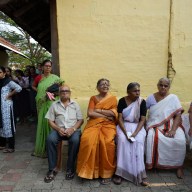 Deputy Chief Kathleen O’Reilly heads the NYPD’s Domestic Violence Prevention Unit.
Deputy Chief Kathleen O’Reilly heads the NYPD’s Domestic Violence Prevention Unit.
Credit: NYPD
Speaking to the chief of the NYPD’s Domestic Violence Unit, it is apparent that one of the most frustrating aspects of that job is a statistic they have seemingly little control over: 70 percent of the victims killed in domestic violence incidents never contacted the police.
“We all know domestic violence is an under-reported crime,” Deputy Chief Kathleen O’Reilly said. “There’s a pool out there that are still afraid to come in and report, or that we’re not able to reach.”
That’s her next big goal, she says: outreach.
“I think that’s where our next step has to be,” she mused. “To let people know that we have these wonderful services and that there is hope, and that we’re there to help.”
A 23-year veteran of the NYPD, O’Reilly has led this unit for a little over two years. She speaks quickly and plainly, goal-oriented and driven, but palpably empathetic when discussing the victims she works with.
She is emphatic about instructing her officers “not to be judgmental or question a person’s motive for staying in an abusive relationship.” She says it’s important for officers to understand the factors that influence those decisions when working with victims: situational reasons like economic dependence, social isolation or lack of housing alternatives; emotional reasons, like an insecurity about being alone, shame, or love; or religious, cultural or family pressures.
One of the first things she did when she took over the unit was to prioritize. The NYPD responds to 250,000 domestic violence incidents a year. The Domestic Violence Unit’s prevention officers can’t visit each home.
“We have to triage on who we visit,” she explained.
The unit always visits elderly victims at least once a month, and makes sure to visit child victims and children who are in homes where they witness violence. They also keep a “high propensity list,” those most likely to be re-victimized. There’s no hard and fast criteria to determine who gets on that list: It could be an escalation from a previously reported incident, or a location where repeated calls are being made. She places her trust in her domestic violence prevention officers in the field to determine who is most vulnerable.
“Sometimes it could be the gut instinct of one of our domestic violence officers,” she said. “He sees something that doesn’t look quite right in the household, for example.”
There are numbers to be pleased about: there was a 28 percent reduction in domestic violence homicides last year, and a 21 percent decrease this year. It seems the unit’s 75,000 yearly home visits are doing some good.
“We don’t know how many lives we save just by knocking on that door,” she said. “I truly believe that, I think we’re making a difference in domestic violence in great strides.”
O’Reilly emphasized one part of the NYPD’s approach that she was especially proud of: their contribution to facilitating what is called “evidence-based prosecution.”
All 34,500 members of the NYPD are trained to treat domestic violence incidents like homicide scenes, she explained. In a homicide, the victim is of course unable to testify against the perpetrator or otherwise assist in the prosecution. Cops are told to approach domestic violence incidents with the same assumption, in order to enable prosecutors “to convict abusers without the cooperation of a victim.”
“As long as we gather the evidence, they can move forward with their case,” she said.
The only time O’Reilly hesitated in discussing her unit was when she was prompted to describe the kinds of injuries they see.
“We see everything,” she said after a pause. “We see a wide variety — specifics, I can’t speak to. We see it all.”
Follow Danielle Tcholakian on Twitter @danielleiat
















